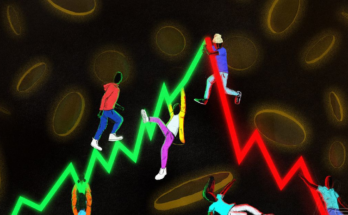Hillary Schieve, the mayor of Reno, Nevada, takes my arm before we jaywalk across the street from City Hall. She continues clutching it as we traverse the gritty public plaza on the other side, and does not let go until we reach the foot, or rather fin, of our destination: a hulking steel and stained-glass sculpture of a humpback whale nuzzling its calf. Its name is the Space Whale. In 2016 a team led by artist Matt Schultz created it for Burning Man, the annual festival held a few hours north of the city, as a means of drawing awareness to “our hypocrisy toward protecting the oceans,” he tells me later. After the festival, the city leased the sculpture for $64,000.
Up close, the whales are looking a little wan. Most of the reachable panes have been shattered, and the metal skeleton is losing its sheen. Schieve, bundled tightly in a coat, her blond hair whipping in a chilly April wind, reaches toward a shard of glass and sighs. “I’m on the save-the-whale campaign,” she says. This was a controversial statement. The lease on the whale had expired in August 2019. The artists had tried to sell it to the city, which had little interest in the $500,000 price tag, and when the price later came down, the city insisted the artists pay for repairs. Schultz’s group then tried to sell it on Facebook Marketplace for $1 million. No takers. All the while, no one was giving the sculpture any TLC. In Schieve’s office, mention of “the whale” elicits an eye roll. A white whale, beached on the banks of the Truckee River.
But this spring, Schieve (pronounced SHE-vee) devised a potential solution: a non-fungible token, or NFT, offered for sale on a blockchain called Tezos. The new owner would receive a .CAD file and a video from the artist, but the actual, physical sculpture would stay in that downtown Reno plaza. The proceeds would raise funds for the city to clean up the whale and preserve it for the public to enjoy. Schieve realized this type of semi-symbolic sale might require some sweetening. So she was contemplating offering benefits, like tagging along on her annual trip to Burning Man with fellow elected officials. (They don’t stay overnight, Schieve adds; she did not intend to jeopardize any future electoral campaigns with drugs and orgies.)
Reno mayor Hillary Schieve
Photograph: Patrick T. Fallon/Bloomberg/Getty ImagesThe issuance of an NFT is not, at this point, such a radical thing, even for a government. Cities and states all over have sought at times to forge links to the blockchain. In 2018, Cleveland declared itself Blockland, though the label seems to have waned. Wyoming has set itself up as the premier regulatory haven for cryptocurrency, a label that other states, including Nevada, now seek to challenge. All it takes is a few interested businesspeople and elected officials receptive to “new ideas,” especially those with a cypherpunk ring. That’s not quite what’s happening in Reno. For Schieve, the NFT was a gateway to something else.
An early sign emerged in January, when Mayor Francis Suarez of Miami, a person on a recent tear of throwing out tech-friendly ideas and seeing what sticks, tweeted about turning his city into a “hub for crypto innovation” centered around Bitcoin. Schieve was unsatisfied. “When are you going to become a $LINK marine?” she teased in reply, cryptically to most readers. She was referring to a blockchain platform called Chainlink, perhaps best known for its cult following of “marines” who swarm toward any mention of the technology on social media. Their loyalty is expressed through ranks earned by #HODLing (that is, holding) the platform’s cryptocurrency, called Link. Apparently, the mayor of Reno was a member of the battalion—“link pilled,” in the community’s parlance. “It was really sweet,” Schieve says of the meme invasion her tweet inspired.





This is a great article. Now I started blogging and distributing inspirational quotes from great philosophers. 951873001